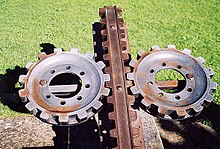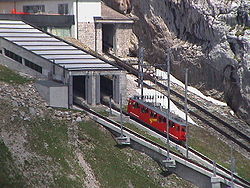Pilatusbahn
| Pilatusbahn | |||||||||||||||||||||||||||||||||||||||||||||||||
|---|---|---|---|---|---|---|---|---|---|---|---|---|---|---|---|---|---|---|---|---|---|---|---|---|---|---|---|---|---|---|---|---|---|---|---|---|---|---|---|---|---|---|---|---|---|---|---|---|---|
|
|
|||||||||||||||||||||||||||||||||||||||||||||||||
| Timetable field : | 473 | ||||||||||||||||||||||||||||||||||||||||||||||||
| Route length: | 4.27 km | ||||||||||||||||||||||||||||||||||||||||||||||||
| Gauge : | 800 mm ( narrow gauge ) | ||||||||||||||||||||||||||||||||||||||||||||||||
| Power system : | 1650 V = | ||||||||||||||||||||||||||||||||||||||||||||||||
| Maximum slope : | 480 ‰ | ||||||||||||||||||||||||||||||||||||||||||||||||
| Rack system : | Perforator | ||||||||||||||||||||||||||||||||||||||||||||||||
| Alpnachstad – Pilatus Kulm | |||||||||||||||||||||||||||||||||||||||||||||||||
|
|||||||||||||||||||||||||||||||||||||||||||||||||
The Pilatusbahn is a cog railway in Switzerland and the steepest of its kind in the world. It leads from Alpnachstad to the Pilatus and is operated by Pilatus-Bahnen AG .
Route description

The train runs on a 4.618 km long narrow-gauge line ( track width 800 mm) and overcomes a height difference of 1635 m. There are also length specifications of 4.27 kilometers, which will refer to the length of the base, as is customary in measurements. The maximum gradient of 48% makes it the steepest rack railway in the world. Since with this incline with conventional racks with vertical engagement there is the risk of the gear climbing out of the rack, Eduard Locher developed a rack with lateral engagement ( toothed wheel system Locher ) especially for this track . Because of this rack, the use of conventional points is not possible - transfer platforms and track reversers are used instead. The wheel flanges of the vehicles, which roll along the outside of the rails, are also a special feature .
The driving speed is 9 to 12 km / h uphill and a maximum of 9 km / h downhill. This results in a journey time of 30 minutes uphill and 40 minutes downhill. The maximum transport capacity is 340 people per hour. The drive power is 210 hp or 154 kW per railcar.
With the inclusion of the 2006 summer timetable, the Ämsigen siding was upgraded to a stop that can also be used regularly by tourists.
Rolling stock
10 railcars are currently in use for 40 people each.
- PB Bhm 1/2 1–11 (all discarded)
- PB Bhe 1/2 21–30 (No. 29 only as a car body , underframe of No. 31)
- PB Ohe 1/2 31 (mostly with interchangeable body as Bhe 1/2 No. 29 on the way)
- PB Xhm 1/2 32
Two steam railcars ( PB Bhm 1/2 ) from the early days of the Pilatus Railway have been preserved to this day. Carriage 9 is at the Museum of Transport Lucerne, the carriage 10 can be in the Deutsches Museum include transportation center in Munich.
history
planning
In Lucerne, the success of the Vitznau-Rigi-Bahn , which initially paid out a return of 15%, aroused the desire to take a cogwheel train up to the Pilatus mountain. A first license application was submitted by the credit institution on April 22, 1873. But there was the problem for the designated route from Alpnachstad to the summit that the 25% gradient that could be achieved with a Riggenbach rack was not sufficient. Eduard Locher made a proposal in 1885 with seven tunnels, a narrower track system and steel anchors fixed deep in the ground to fix the tracks. This suggestion enabled a gradient of an average of 38% and a maximum of 48% on a brick-built base.
construction
On the basis of this proposal, a realization could be started in April 1886. The route was built in sections. Construction started in the valley. The granite stones were transported to the next construction section on chassis with loading platforms for goods transport. The first of the ordered steam locomotives were used for this. The route and the rail structure as well as the machines were already tested under load during the construction phase. The car bodies for passenger traffic were only built onto the chassis at the end. The first passenger train journey took the members of the Board of Directors of the Pilatusbahn AG up the mountain on August 17, 1888. The steam car No. 7 was shown at the World Exhibition in Paris in 1889 .
opening
The line was opened on June 4, 1889 and the train ran in steam mode, for this purpose a railcar with a boiler positioned transversely to the direction of travel was constructed. This was necessary so that the fuel and water remained largely stable despite the different gradients. Initially, on the basis of a count of 3,000 mountain climbers, transport capacities for 288 people per trip were created annually and an average of 34,400 people were transported to the mountain hotel in the first ten years. The success of the Pilatusbahn was expressed in the first years of operation through a dividend of 7% on the company's capital. This gave new impetus to the construction of further mountain railways, which had been stalled for over a decade. For example, Eduard Guyer-Zeller and Eduard Locher were able to implement the Jungfrau Railway project.
electrification
If the motor coaches were not motorized enough at the start of operation, 50 years later electric motor coaches were able to provide the required performance. In 1936 the railway got a contact line and new red railcars. After switching to the electric drive, the railway was reopened on May 15, 1937.
Accidents
On April 20, 1970 at 10.15 am, while clearing the snow (the so-called “snow break”), twenty workers on the cog railway were surprised by the “Heumattli avalanche”. Twelve of these men were employees of the Pilatus Railways , the other eight were Spanish guest workers from an Obwalden construction company. The scene of the accident was around 500 meters above the Ämsigen crossing station. A group of seven workers was hit directly by the massive avalanche. Three of the buried men - two locals and a Spanish guest worker - were quickly freed from the snow by the colleagues hurrying up; one was seriously injured and two were moderately injured. Three other men in the group were located by the rescue troops arriving around noon with two search dogs, but unfortunately could only be rescued dead. The fourth fatally injured person - it was the railway master responsible for clearing the snow - was only found on June 2nd. Three of the four men in the fatal accident were locals and long-term employees of the Pilatus Railways. The fourth was a 19-year-old Spaniard from the Zamora province . In the same year 1970, a cable car operator had lost his life in a tragic accident while blowing snow on Pilatus-Kulm at the end of February.
Cultural and technological history significance
The Pilatusbahn with valley station is listed in the Swiss inventory of cultural assets of national and regional importance as cultural assets of national importance .
In 2001 the American Society of Mechanical Engineers classified the Pilatusbahn as a Historic Mechanical Engineering Landmark .
literature
- Verena Gurtner: Pilatus via Lucerne . Orell Füssli, Zurich 1975, ISBN 3-280-00784-4 .
- Marco Volken, Peter Krebs, Caroline Fink: Pilatusbahn experience - the steepest cogwheel train in the world . AS Verlag , Zurich 2014, ISBN 978-3-906055-22-0 .
Web links
- History of the Pilatus Bahn on the Pilatus-Bahnen AG website
Individual evidence
- ↑ The world's steepest cog railway on the Pilatus on the Pilatus-Bahnen AG website, accessed on October 15, 2018
- ↑ Information on own website
- ^ Mountain railways in Switzerland (1959), Swiss rail network (1980), CH + (2010)
- ↑ Photo of Bhe 1/2 27 , on railpictures.net
- ↑ Gurtner 1975, p. 33
- ↑ Gurtner 1975, p. 38
- ↑ Gurtner 1975, p. 48ff
- ↑ Gurtner 1975, p. 51
- ↑ Gurtner 1975, p. 42f
- ↑ Gurtner 1975, p. 61f
- ↑ Gurtner 1975, p. 65
- ↑ http://www.pilatus.ch/de/bergbahnen/zahnradbahn/geschichte/
- ^ Black Monday in Central Switzerland. In: Lucerne Latest News , April 21, 1970.
- ↑ Pilate: The death avalanche came in fog. In: Luzerner Tagblatt , April 21, 1970.
- ↑ On Pilate the White reaped death. In: Vaterland , April 21, 1970.
- ↑ The missing railway master has been found. In: Lucerne Latest News, June 3, 1970.
- ↑ Like springs in a hurricane - memory of the fatal avalanche of 1970 on Pilatus. In: Luzerner Zeitung , April 20, 2020.
- ↑ In the shadow of tragic events. In: Lucerne Latest News, May 30, 1970.
- ↑ Swiss inventory of cultural assets of national importance, Canton Obwalden on the website of the Federal Office for Civil Protection (pdf)
- ↑ Pilatusbahn on www.asme.org
Coordinates: 46 ° 57 ′ 20 " N , 8 ° 16 ′ 37" E ; CH1903: six hundred and sixty-three thousand eight hundred and eleven / 200838




